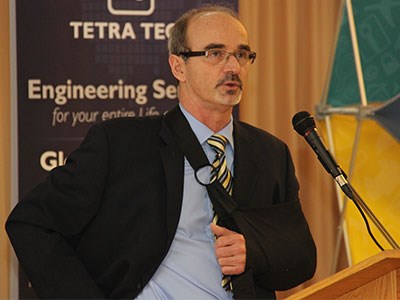The province was “blinded” by Cliffs Natural Resources' promises to invest in the Ring of Fire to the detriment of the project's development, said Moe Lavigne, KWG Resources' vice-president of exploration and development.
“At least from the provincial point of view, they were enamoured with Cliffs, and the fact Cliffs had $3.5 billion in their pockets ready to invest, and they shuttered out everything else,” Lavigne said at a Sudbury Chamber of Commerce event, April 3. “Now that has blown up.”
In 2009, the Toronto-based junior miner began staking mining claims in the Ring of Fire for a future railroad from its isolated Big Daddy chromite deposit in the James Bay lowlands, heading south for 328 kilometres to a point on the Canadian National Railway's main line, just west of the village of Nakina in northwestern Ontario.
Both KWG and the Ohio mining giant were development partners in the Ring at one time, but had a falling out. Later, when Cliffs approached KWG to gain access to its transportation corridor, KWG refused and the matter went to the Ontario Mining and Lands Commissioner.
The tribunal ruled against Cliffs, which later filed a court appeal, with a hearing scheduled June 16 and 17. The provincial government has requested to weigh in on the appeal.
Lavigne did not pull his punches against Queen’s Park, which he said has not done enough to support development in the Ring of Fire.
“They don't understand there's another way besides the project Cliffs presented to them,” he said. “I don't know if they have the technical capacity to understand what we're doing. I don't know if they understand mining strongly enough to be able to make these decisions.”
Last November, Cliffs ceased work on its $3.3-billion Black Thor mine and refinery project due to a number of hurdles including the lack of a provincial infrastructure plan and agreements with area First Nations.
But KWG and junior miner Noront Resources have continued push forward with their Ring of Fire projects.
Lavigne said for development to move forward the province must invest in the necessary transportation infrastructure.
“The problem with all those deposits is that we simply can't go up there as a private corporation and start building roads on Crown land,” he said. That takes co-operation firstly from the First Nations, but it also takes participation from the province.
“They really have to take the lead on regional infrastructure. Private corporations don't do regional infrastructure, they develop mines.”
The Wynne government recently announced a framework agreement with the Matawa First Nations, a group of Aboriginal communities closest to the string of chromite and base metal deposits, in an effort to move forward with mineral and community development in the remote region.
The development of a provincial infrastructure plan has been contracted out to Deloitte Canada.
On the federal side, FedNor director general Aime Dimatteo said last month that mining companies operating in the Ring of Fire would have to make a business case for development before the federal government makes any investment decisions.
“At the end of the day, the businesses will make the decisions on whether they're going to go forward with these projects,” Dimatteo said.
Lavigne said KWG has made its business case with a sustainable plan for rail and a more efficient refining method to process the chromite.
“We don't want to build a fragile industry that shuts down one year and opens the next year, and creates chaos in the communities,” he said. “You've seen that movie, and we don't want to do that.”
Through its own privately-financed study, KWG has estimated a north-south railroad to their Ring of Fire deposits would cost $1.55 billion to build, while a road along the same route would cost $1.05 billion.
But the lower operational costs for a rail line would bring a return on investment of the initial capital expenditure within six years, Lavigne said. A road would cost $60.78 to transport a tonne of ore, while a rail line would cost $10.50.
“A railroad is the way to go,” Lavigne said.
To refine chromite to make stainless steel, KWG has filed a patent for a method to process the ore with a natural gas-fired furnace instead of using electricity.
The technique, which introduces an accelerant into the mix to process the ore at a lower temperature – 900 C instead of 1,600 C with an electric furnace – would free the company from Ontario's high power rates and drastically reduce greenhouse gas emissions, Lavigne said.
Gas furnaces have been used to process iron ore, but the technique has never been used with chromite, Lavigne said.
There are four natural gas furnaces used to process iron-ore, and Lavigne said they could be used for chromite after some modifications.




